với
những
họat
động
vì
hòa
bình
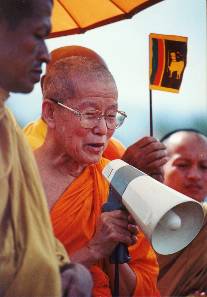
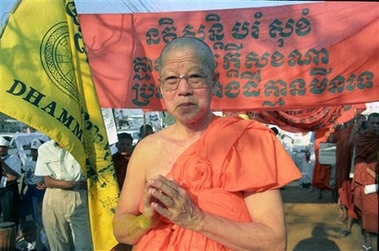
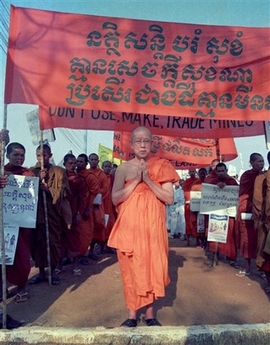
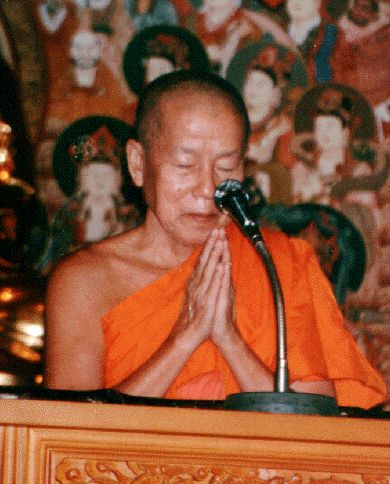
http://www.buddhistchannel.tv/
http://en.wikipedia.org/wiki/Preah_Maha_Ghosananda
-oOo-
Nobel Peace
Prize-nominated Maha Ghosananda passes away
THE ASSOCIATED PRESS, March 13, 2007
NORTHAMPTON, Mass. (USA) -- Maha Ghosananda, a Nobel Peace Prize-nominated monk who rebuilt Buddhism in Cambodia after the fall of the Khmer Rouge, has died.
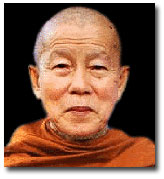 << Somdet
Phra Maha Ghosananda (1929 - 2007)
<< Somdet
Phra Maha Ghosananda (1929 - 2007)
Ghosananda, who lived in Leverett and Providence, R.I., was believed to be in his late 70s. He died Monday at Cooley Dickinson Hospital, said Christina Trinchero, a hospital spokeswoman. Trinchero did not know the cause of death or his age.
The Cambodian monk lived in exile between 1975 and 1979, when the Khmer Rouge denounced Buddhism and killed nearly two million people through starvation, disease, overwork and execution.
Ghosananda was one of the first monks to return to Cambodia and train new Buddhist leaders after Pol Pot's regime was toppled by the Vietnamese in 1979.
"He did everything he could to restore Buddhism to Cambodia," said Jim Perkins, pastor of the Leverett Congregational Church and a friend of the religious leader.
Ghosananda was elected a Supreme Cambodian Buddhist Patriarch by fellow Buddhist monks in 1988 for restoring Buddhism in the war-torn country.
During the 1990s, he lead the Dhamma Yatra movement to rebuild religious life in Cambodia.
He moved to western Massachusetts in the late 1980s at the invitation of the Nipponzan Myohoji Buddhist order in Leverett, which seeks a complete elimination of weapons, and was nominated for the Nobel Peace Prize three times in the mid-1990s.
Cambodians
regret death of top Buddhist monk
People's Daily, March 14, 2007
Phnom Penh, Cambodia -- Cambodian officials, monks and followers on Wednesday regretted the death of top monk Maha Ghosananda.
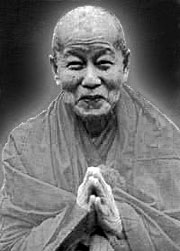 <<
Bhante Maha Ghosananda (1929 - 2007)
<<
Bhante Maha Ghosananda (1929 - 2007)
The Cambodian government very much regretted for losing Ghosananda, who contributed much to Cambodia in helping restore peace, develop Buddhism, and stop violence in the country, said Minister of Information Khieu Khanharith.
Ghosananda died on Monday at the age of 78 in hospital in Massachusetts, the United States. The cause of his death is unclear yet.
Kong Nam Many, chief monk at the Sampov Meas Pagoda in Phnom Penh, told Xinhua that Ghosananda, when in Cambodia, used to say that he wanted to die in his homeland.
"He usually stayed in a small room in our pagoda. He founded the Non-Violence Dharmayeatra Center for Peace and Humanity in our pagoda," he said.
In addition, Ghosananda wrote a book named Step by Step for Cambodian Buddhists to learn about the religion, he said.
Ta Ry, one of the monk's followers, told Xinhua that Ghosananda left Cambodia for the United States in the late 1980s to help the Cambodian communities there learn about Buddhism and build pagodas.
The "Gandhi of Cambodia"
Source: Unknown, Published on the Buddhist Channel, March 15, 2007
A tribute to the great compassionate, reformist monk, Bhante Maha Ghosananda
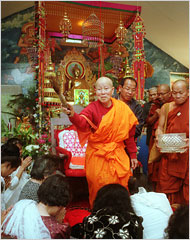
Kuala Lumpur, Malaysia -- Bhante Maha Ghosananda was one of few Cambodian monks to survive the brutal purge instigated by Pol Pot and the Khmer Rouge. During the reign of the Khmer Rouge, he studied under numerous Buddhist masters from every tradition, and helped tend to the spiritual and material needs of the Cambodian refugee community. Following the fall of the Khmer Rouge, Maha Ghosananda became the leader of the gradually recovering Cambodian Sangha (his title is "Sangha raja", which is variously translated. "Supreme patriarch").
Maha Ghosananda was born in 1929 to a farming family in the Mekong Delta plains. From an early age he showed great interest in religion, and began to serve as a temple boy at age eight. He greatly impressed the monks with whom he served, and at fourteen received his parent's permission to ordain as a Buddhist monk (bhikkhu). He went on to study at monastic universities in Phnom Penh and Battambang, before going to India to pursue a doctorate in Pali at Nalanda University in Bihar.
Before the age of 30, Ghosananda was granted the title "Maha" in recognition of his skill at the monastic Pali language exams. He went on to study under a variety of teachers, including the Japanese monk Nichidatsu Fujii and the Cambodian Patriarch Samdech Prah Sangha Raja Chuon Noth. From Nichidatsu Fujii, Maha Ghosananda received training in mediation and nonviolent resistance (Fujii was an associate of Mahatma Gandhi), and by studying under the Cambodian Sangha Raja was marked as a rising star of the Cambodian monastic community.
In 1965, Maha Ghosananda left Cambodia to study meditation under the Thai master Achaan Dhammadaro, a guiding light of the Thai Forest Tradition. Four years later, while he was still studying at Dhammadaro's forest monastery, the United States began bombing Cambodia as part of their attempt to shut down the Ho Chi Minh trail and end the Vietnam War. A year later, a full-blown civil war was underway in Cambodia.
As the Khmer Rouge seized control of the country, the prospects for Buddhism in Cambodia became increasingly dim. Pol Pot, who once had served in a Buddhist monastery, identified the monks and temples as part of the power structure of feudal Cambodia that must be overthrown and destroyed. Furthermore, monks were considered to be part of the intellectual class, which was targeted for especially brutal treatment and "reeducation".
As part of Pol Pot's horrific year zero campaign, monks were systematically turned out of monasteries and murdered or sent to "reeducation facilities" (which is to say, they were tortured, and then murdered). Some monks were forced to violate their vows (most often through forced copulation at gunpoint) so that they would not get any ideas about continuing to act as monks. By the time the Khmer Rouge ended its reign of terror, most Cambodian monks were dead, and most temples and monasteries were rubble.
Meanwhile, Maha Ghosananda continued to study under the guidance of Achaan Dhammadaro for nine years. Though eager to attempt to help his people, he was advised by his teachers to wait for a better opportunity. Finally, in 1978, he saw an opportunity to help his people, as the first refugees from Pol Pot's coup and ensuing reign of terror began to arrive in Thailand. He traveled to Sakeo, on the Thai side of the Thai-Cambodian border, where Cambodian refugees were arriving in droves.
Maha Ghosananda's appearance raised a stir among the refugees; to wear the robes of a monk in public was to invite a death sentence in Cambodia- most likely, none of the refugees had seen a monk in years. Maha Ghosananda began to distribute photocopies of Buddhist scripture among the refugees, and to revive their lapsed and battered religious practices.
By 1978, Maha
Ghosananda's entire family had been killed by Pol Pot's Communist
regime. Yet, when Vietnam invaded Cambodia and sent the Khmer Rouge into
retreat, he traveled to the refugee camps of the former Communist
militants just as he had traveled to the camps of
those they had displaced. His reception was much the same; amazement,
followed by grateful weeping.
"Our journey for
peace begins today and every day. Each step is a prayer, each step is a
meditation, each step will build a bridge." - The Late Ven Maha
Ghosananda
In addition to handing out copies of the Metta Sutta and establishing new temples in refugee camps, Maha Ghosananda worked to bring about peace and reconciliation in his war-torn homeland.
When Pol Pot's regime collapsed in 1979, Maha Ghosananda was one of only 3,000 Cambodian Buddhist monks alive- out of 60,000 at the start of his reign of terror in 1976. In 1988, he was elected Supreme Buddhist Patriarch of Cambodia (dhamma raja) by the Cambodian Sangha.
In 1992, during the first year of the peace agreement, Maha Ghosananda led the first nation-wide Dhamma Yatra, a walk for peace across Cambodia. The Dhamma Yatra (Pali, 'yatra' journey or pilgrimage) is much more than an elaborate walk-a-thon. Every year, more than 200 marchers, many of them ordained Buddhist monks from a variety of traditions, travel the roads of Cambodia, praying for peace, blessing villagers and regional leaders, and drawing media attention to the numerous problems that plague post-war Cambodia- illegal logging, unexploded land mines, inadequate sanitation, the plight of the numerous war orphans, and the loss of Cambodian culture.
The route that the Dhamma Yatra takes is far from a walk in the park. Every year, Maha Ghosananda and other organizers work to plan a route for the march, a route that is almost always guaranteed to carry the marchers into danger and uncertainty. In its second year, the marchers passed through contested territory just prior to the first U.N monitored elections, encouraging Cambodians to resist attempts at voting intimidation. During the next year, they passed through the most contested and war-torn areas of Cambodia, and two walkers were killed when they were caught in crossfire between government and rebel forces. In 1997, the path of the walk passed through areas that had been, until the previous few months, entirely under former Khmer Rouge hard-line control. The Dhamma Yatra marchers were sometimes first contact with the outside world that the people of this region had had in decades.
Whatever the route taken, the Dhamma Yatra walkers are always received with great joy and appreciation by the Cambodian people. They have re-dedicated Buddhist temples damaged or desecrated during the war years, and are helping not only to improve the political and physical circumstances of the Cambodian people, but also to renew and revitalize Cambodian religion.
In 1994, Maha Ghosananda was nominated for the Nobel Peace Prize by the chair of the U.S Senate Foreign Relations Committee, Claiborne Pell. He was again nominated in 1995, 1996, and 1997 for his work in bringing peace and stability to Cambodia. In 1998, he received the Niwano Peace Prize in recognition of his commitment to peace and inter-religious understanding. He has also acted as an advisor to the Buddhist Peace Fellowship, and has been involved in campaigning for negotiations to end the civil war in Sri Lanka. In 1997, he staged the first mass coordinated mass event to protest the use of violence in Cambodian politics, following a coup d'etat, and was recognized with an award from Sri Lanka's Sarvodaya Srimadana organization.
In Cambodia, it is said that Maha Ghosananda is a true monk, that he would give his daily meal and robes to anyone that asked for them. He is called "Cambodia's Gandhi", a "living treasure", and the "living Truth" (Dhamma). His commitment to peace and the people of Cambodia has persevered for his entire life, despite exile, great difficulty, and the loss of his entire family, as well as most of his teachers and friends.
Somdet Phra Maha Ghosananda "The Gandhi of Cambodia"
Buddhist University, Phnom Penh - graduate.
Buddhist University, Battambang - advanced studies.
Somdet Phra Sangha Raja Chuon Noth.
[who was Supreme Patriarch of Cambodian Buddhism at the time]
Nalanda University, India - doctorate.
Zen Japanese - Nichiren School Nipponzan, Myohoji Sect founder
Nichidatsu Fujii.
Theravada - Thai forest tradition: Ven. Achaan Dhammadaro.
• 1929 Born Takeo Province, south central Cambodia.
• 1943 Initiated into Cambodian Buddhist Order.
• 1953 Studied at Nalanda University in Bihar State, India.
• 1956 Attended 6th Sangha Council of Buddhism.
• 1957 Studied with contemporary masters of Buddhism in Mahayana and
Theravada traditions.
• 1969 Received doctoral degree from Nalanda University, title "Maha
Ghosanada" bestowed.
Entered hermitage of Thai meditation master Venerable Achaan Dhammadaro.
• 1978 Met first influx of Cambodian refugees entering Sakeo camp
following expulsion of Khmer Rouge regime from power. Distributed tracts
to the refugees, reminding them of Buddha's words: "Hatred can never be
appeased by hatred, hatred can only be appeased by love."
• 1978- Established temples in refugee camps on the Thai-Cambodia
border.
• 1980 Represented Khmer nation-in-exile as consultant to the UN
Economic and Social Council.
Co-founded Inter-religious Mission for Peace. Launched ecumenical
initiatives, world days of prayer for "Peace in Cambodia and the Whole
World."
• 1981 Founded Buddhist temples in Cambodia and Cambodian resettlement
communities in North America, Europe and Australia; currently oversees
temples, establishes cultural and educational programs, sponsors
meditations for peace, sponsors training programs for human rights
advocacy and development of nonviolent conflict resolution.
• 1983 Met with His Holiness Pope John Paul II in Rome to discuss
religious basis for world peace before planned meeting in Assisi.
• 1986 Invited by Pope to participate in Day of Prayer for Peace with
world religious leaders in Assisi (now an annual event always attended
by Maha Ghosananda).
• 1988-1991 Led contingents of Buddhist monks to U.N. - sponsored
Cambodian peace negotiations, proposing a compromise and reminding
national leaders that "Peace is our common goal."
• 1988 Elected a Supreme Patriarch of Buddhism in Cambodia.
1989 Granted honorary doctorate of humanitarian service at Providence
College, Providence, RI, USA.
• 1992 Received the title Somdet Phra from King Sihanouk in Phnom Penh.
Popularly known as Samdech Song Santipeap (the leaders of Religion for
Peace) in Cambodia.
Led the First Dhammayietra-Walk for Peace and Reconciliation for one
month through northern Cambodia just prior to full implementation of
United Nations Transitional Authority in Cambodia (UNTAC).
"Step by Step: Meditations on Wisdom and Compassion" by Maha Ghosananda
was published by Parallax Press, USA (since translated and published in
Khmer, Thai, Spanish and Portuguese).
Awarded 1992 Rafto Foundation Prize for Human Rights, Bergen, Norway.
• 1993 Led Second Dhammayietra through area of civil war before first
Cambodian elections, encouraging citizens to overcome fear of political
violence and intimidation and exerice their right to vote.
Named honorary leader of Ponleu Khmer, citizens' advisory council to the
Cambodian Constitutional Assembly. Ponleu Khmer presents proposals for
the protection of human rights and for nonviolent resolution of the
continuing Cambodian conflict.
Invited to attend the Parliament of the World's Religions in Chicago.
• 1994 Asked to bless the opening ceremony of the Interfaith Pilgrimage
for Peace and Life at Auschwitz, Poland.
Led Third Dhammayietra through the most heavily war-torn western
province of Cambodia. The walk was caught in crossfire between
government and rebel forces and two peace walkers were killed.
Proclaiming "this violence is indeed the reason we walk," Maha Ghosanada
led the Dhammayietra to its completion.
Led contingent of highest-ranking monks to peace negotiations held under
the auspices of King Sihanouk in Pyongyang, North Korea and to a second
round of negotiations later in Phnom Penh.
Led interreligious delegation to peace negotiations in Colombo, Sri
Lanka, to help seek an end to that country's long-standing civil war.
Nominated for 1994 Nobel Prize for Peace by US Senator Claiborne Pell,
Chairman of US Senate Foreign Relations Committee.
• 1995-1997
- 1995 Nominated for a second time by Sen. Pell and an anonymous Nobel
laureate for 1995 Nobel Peace Prize.
- January: Dedicated Disabled Persons' Center, Phnom Penh.
- February: INEB conference, ashram, Nakhon, Nayok, Thailand.
- March: International Women's Day, Phnom Penh/Battambang.
- March: Buddhist Teachers' Meeting (Asian-Western) Dharamsala, India.
- April: International Consultancy on Religion, Education and Culture,
Atami, Japan.
International Consultancy on Religion, Education and Culture, Windsor
Castle, UK.
- May: Cambodian Engaged Buddhist Nuns and Laywomen, conference in
Takmau.
- May-June: Led Fourth Dhammayietra for Peace and Reconciliation in
Cambodia, walking from the Thai border to the Vietnamese border.
Continued calls for peace negotiations and educating public about the
ongoing dangers from land mines and Unexploded ordinance in Cambodia.
- September: Preparatory meeting for a Peace Council, UK. Led
International Peace Day Ceremonies, during Cambodian Festival of the
Dead, for a ban on land mines.
- October: Attended UN Review Conference on the Convention on
Conventional Weapons to present the suffering of ordinary people due to
land mines and plea for a total ban on them. Toured Italy at invitation
of the Italian Campaign to Ban land mines.
- November: Founding meeting of the Peace Council at Windsor castle, UK.
The Peace Council includes several Nobel laureates and high
representatives of all major world religions.
- 1996 Nominated for the Nobel Prize for Peace for third year in a row.
Nominated in 1996 by American friends service Committee (1967 Nobel
Prize recipients).
- February: Led Ban Mines Week parade in Phnom Penh for a ban on land
mines.
- April: Attended UN Review Conference on Conventional Weapons, Geneva,
to plea for a total ban on land mines.
- May-June: Led the Fifth Dhammayietra for Peace and Reconciliation in
Cambodia, focusing on deforestation and the link between the military,
illegal logging and the on going civil war. Drew a link between healthy
forests and the life of the Buddhist order. Members of Peace Council
join the walk.
- July: Invited to represent Theravada Buddhist lineage at Gesthemane
Encounter, a Christian-Buddhist Monastic Dialogue at Gesthemane, Abbey,
USA.
- September: Met with opressed Nobel laureate Aung San Suu Kyi and
Buddhist Sangha in Burma October Delegates, State of the World Forum in
San Francisco, California, USA November Met with Bishop Ruiz and members
of Zapatistas in Chaipas, Mexico, as a member of the Peace Council.
- December: Met with members of Khmer Rouge to arrange a route for the
1997 Walk for Peace and Reconciliation in Cambodia. Was Patron of
conference on Buddhism and Peace in Battambang, Cambodia, which was
organized by Buddhism for Development group and was attended by
representatives of different militant factions.
- 1997 Nominated by a former Nobel laureate (anonymous) for the Nobel
Prize for Peace for a fourth time.
- March-April: Led the Sixth Dhammayietra through areas of Cambodia
which were, until a few months before, under the total control of the
Khmer Rouge. The people in the areas through which the walk passed
witnessed the first freely organized event in their lives. Walk
successfully concluded at the Angkor period ruins of Bantey Chammar.
- May: Invited by His Holiness the Dalai Lama to co-lead an ecumenical
service for Tibet at the national Cathedral in Washington, D.C.
- June: As a Patron of the organization, he attended the International
Network of Engaged Buddhists conference in Kanchanaburi province,
Thailand, which brought together Buddhist social activists from
throughout Asia and around the world. Visited Halockhani refugee camp on
the Burma-Thai border at the invitation of the New Monk Relief
Committee.
- August: After the coup d'etat in July he led the first mass event
calling for an end to the use of violence in Cambodian power struggles.
He later traveled to Sri Lanka, where he received an award for
peacemaking from the Sarvodaya organization.
Wat Sampeou Meas is the main temple, but although Samdech has established over 50 temples, he has no connections with any of them. For famous man, he is notoriously hard to get hold of. A constant traveller, even his disciples do not know where he is much of the time. Interested persons may try following:
Ven. Maha Ghosananda
c/o Mr. ONG Vuthy
Coordinator, The Dhammayietra Center, for Peace and Non-violence
Phnom Penn, CAMBODIA
Fax: (855 23) 36-4205
• International Network of Engaged Buddhist (INEB) Website:
INEB is under the patronage of His Holiness the Dalai Lama, Venerable
Somdet Phra Maha Ghosananda, and Venerable Thich Nhat Hanh. Founded in
1987, INEB is the first international network that links together
engaged Buddhists worldwide. INEB deals with alternative education and
spiritual training, gender issues, human rights, ecology, alternative
concepts of development, and activism. Primarily a Buddhist network,
INEB encompasses interfaith elements.
By Somdet Phra Maha Ghosananda:
Step by Step: Meditations on Wisdom and Compassion
Parallax Press, USA
also in Khmer, Thai, Spanish and Portuguese.
By western students referring to their experiences at teachers temples:
An Introduction to Buddhist Ethics, by Peter Harvey.
By students in teachers lineage:
Action Dharma, eds. Queen, Keown & Prebish, has chapter on Maha Ghosananda.
____
Source:
http://www.buddhistchannel.tv/
http://www.buddhanet.net/masters/maha-gosanada.htm
|
Mục lục
|
Xứ
Sở
|
Sự
kiện
|
Nhân
Vật
|
Phụ
Lục |
---o0o---
|Danh
Nhân
Phật Giáo Thế
Giới
Kỹ thuật vi tính:
Trình bày: Nhị Tường
Cập
nhật: 14-3-2007
Nguồn: www.quangduc.com

